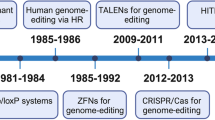Abstract
Programmable nucleases, such as zinc finger nucleases, TALE nucleases, and CRISPR-Cas nucleases, allow for the introduction of precise modifications in the human genome. As a consequence, targeted genome editing has heralded a new area for gene therapy and the treatment of acquired and inherited disorders. Here, we describe the concept of designer nuclease- mediated genome engineering, discuss risks and potential limitations of its usage, highlight some of the achieved milestones, and review the most prominent studies that have made it from the laboratory to the clinic.
Similar content being viewed by others
Literatur
Bednarski C, Cathomen T (2015) Maßgeschneidertes Genom–Designer-Nukleasen im Einsatz. BIOspektrum 1:22–24
Carroll D (2011) Genome engineering with zinc-finger nucleases. Genetics 188:773–782
Mussolino C, Cathomen T (2012) TALE nucleases: tailored genome engineering made easy. Curr Opin Biotechnol 23:644–650
Doudna JA, Charpentier E (2014) Genome editing. The new frontier of genome engineering with CRISPR-Cas9. Science 346:1258096
Carroll D (2014) Genome engineering with targetable nucleases. Annu Rev Biochem 83:409–439
Haas SA, Dettmer V, Cathomen T (2017) Therapeutic genome editing with engineered nucleases. Hamostaseologie 37:45–52
Tsai SQ, Joung JK (2016) Defining and improving the genome-wide specificities of CRISPR-Cas9 nucleases. Nat Rev Genet 17:300–312
Miller JC, Zhang L, Xia DF et al. (2015) Improved specificity of TALE-based genome editing using an expanded RVD repertoire. Nat Methods 12:465–471
Author information
Authors and Affiliations
Corresponding author
Additional information
Viviane Dettmer 2009–2014 Bachelor- und Masterstudium in Human- und Molekularbiologie an der Universität des Saarlandes. 2014–2015 ASTAR Trainee Scholarship Singapore. Seit 2015 Doktorandin am Institut für Zell- und Gentherapie und am Centrum für Chronische Immundefizienz, Universitätsklinikum Freiburg.
Toni Cathomen 1998 Promotion an der Universität Zürich, Schweiz. 1999–2003 Postdoktorat am Salk Institute in San Diego, CA, USA. 2003–2009 W1-Professur an der Charité in Berlin. 2009–2012 W2-Professur an der Medizinischen Hochschule Hannover. Seit 2012 W3-Professor und Direktor des Instituts für Zell- und Gentherapie am Universitätsklinikum Freiburg.
Markus Hildenbeutel 2006 Diplom in Biologie an der Universität Heidelberg. 2007–2011 Promotion an der TU Kaiserslautern. 2011–2014 Postdoktorandenstipendium der Wenner-Gren-Stiftung, Universität Stockholm, Schweden. Seit 2015 Postdoktorand am Institut für Zell- und Gentherapie und am Centrum für Chronische Immundefizienz, Universitätsklinikum Freiburg.
Rights and permissions
About this article
Cite this article
Dettmer, V., Cathomen, T. & Hildenbeutel, M. Genom-Editierung — neue Wege im klinischen Alltag. Biospektrum 23, 155–158 (2017). https://doi.org/10.1007/s12268-017-0781-9
Published:
Issue Date:
DOI: https://doi.org/10.1007/s12268-017-0781-9




